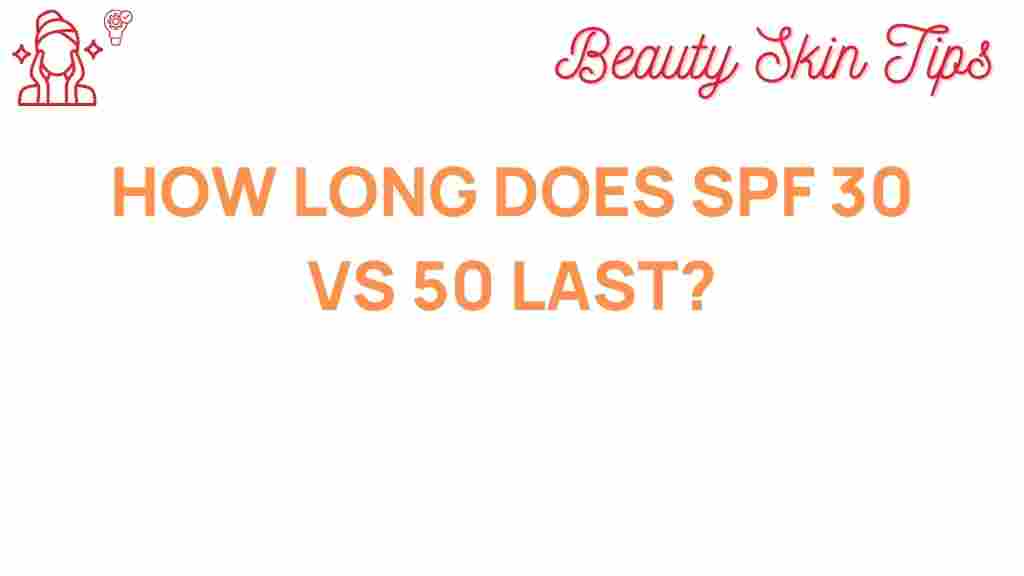The Truth About SPF Duration
When it comes to sun protection, understanding the SPF duration is crucial for effective skincare. SPF, or Sun Protection Factor, is a measure of how well a sunscreen can protect your skin from UVB rays, the type of radiation that causes sunburn and contributes to skin cancer. Many people are unsure whether to choose SPF 30 or SPF 50, and how long each of these sun protection factors actually lasts when applied correctly. In this article, we will explore the differences between SPF 30 and SPF 50, the factors influencing SPF duration, and provide practical tips for optimal sun protection.
Understanding SPF: What Do the Numbers Mean?
SPF numbers indicate the level of protection provided against UVB rays. For example:
- SPF 30: Provides approximately 97% protection against UVB rays.
- SPF 50: Offers around 98% protection against UVB rays.
While the difference in percentage might seem minimal, the implications of prolonged sun exposure can be significant. So, how long does each SPF last? The SPF duration depends on several factors including skin type, activity level, and application method.
How Long Does SPF 30 Last?
SPF 30 sunscreen generally lasts for about 2 hours under ideal circumstances. However, this duration can be affected by:
- Water exposure: If you’re swimming or sweating, SPF 30 may need to be reapplied more frequently.
- Skin type: Individuals with fair skin may need to reapply more often than those with darker skin tones.
- Application amount: Applying too little sunscreen can significantly reduce its effectiveness.
To ensure the best results, it is recommended to apply a generous amount of SPF 30 sunscreen every two hours, or immediately after swimming or sweating.
How Long Does SPF 50 Last?
SPF 50 sunscreen offers a slightly longer SPF duration compared to SPF 30, but the difference is not as substantial as many believe. SPF 50 also lasts around 2 hours under normal conditions. Key considerations include:
- Higher Protection: SPF 50 provides marginally better protection, which can be beneficial for those with very fair skin or specific health conditions.
- Frequency of Reapplication: Similar to SPF 30, it is vital to reapply SPF 50 every two hours or after swimming or heavy sweating.
Factors That Affect SPF Duration
Understanding the SPF duration of your sunscreen is essential, but several factors can influence its effectiveness:
1. Skin Type
Your skin type plays a crucial role in how long sunscreen lasts. Fair-skinned individuals tend to burn more quickly and may need to apply sunscreen more frequently than those with darker complexions.
2. Activity Level
Engaging in activities that cause sweating or involve water can significantly reduce the effectiveness of sunscreen. If you’re swimming or exercising, consider using water-resistant formulas.
3. Application Method
The way you apply sunscreen matters. For optimal protection:
- Apply sunscreen generously to all exposed skin.
- Use about an ounce (a shot glass full) for full-body coverage.
- Don’t forget areas like ears, feet, and the back of your neck.
4. Expiration Date
Always check the expiration date on your sunscreen. An expired product may not provide the advertised level of protection, leading to decreased SPF duration and effectiveness.
Step-by-Step Guide to Applying Sunscreen
To maximize the effectiveness of your sunscreen and ensure proper SPF duration, follow these steps:
Step 1: Choose the Right Sunscreen
Select a broad-spectrum sunscreen that blocks both UVA and UVB rays. Consider your skin type and any sensitivities when choosing a formula.
Step 2: Apply Generously
Use enough product to cover all exposed skin. As mentioned, approximately one ounce is ideal for full-body coverage.
Step 3: Reapply Regularly
Reapply every two hours, or immediately after swimming, sweating, or towel drying. If you’re using a spray sunscreen, ensure you apply a thick layer and rub it in for even coverage.
Step 4: Don’t Forget Other Protective Measures
In addition to sunscreen, wear protective clothing, a wide-brimmed hat, and sunglasses. Seek shade when the sun is at its strongest, typically between 10 AM and 4 PM.
Troubleshooting Common Sunscreen Issues
Even with the best intentions, you may encounter challenges while using sunscreen. Here are some troubleshooting tips to ensure optimal SPF duration:
1. White Cast
If your sunscreen leaves a white cast, opt for tinted formulations or mineral-based sunscreens that blend better with the skin.
2. Breakouts
Choose non-comedogenic sunscreens which are less likely to clog pores. Test products on a small skin area before full application.
3. Allergic Reactions
If you experience irritation or an allergic reaction, discontinue use and consult a dermatologist for alternatives.
Conclusion: Making the Right Choice for Your Skin
Understanding the SPF duration of sunscreen is essential for effective sun protection. While SPF 30 and SPF 50 offer similar durations of protection, the choice between them should be based on your skin type, activity level, and personal preference. Regardless of the SPF you choose, remember to apply it generously and reapply regularly for the best results.
For more information on sun safety, visit the American Academy of Dermatology for valuable resources and advice. Additionally, explore our other articles on sunscreen selection tips to ensure you are always protected against harmful UV rays.
By following these guidelines, you can enjoy your time outdoors while keeping your skin safe and healthy!
This article is in the category Skincare and created by BeautySkinTips Team
